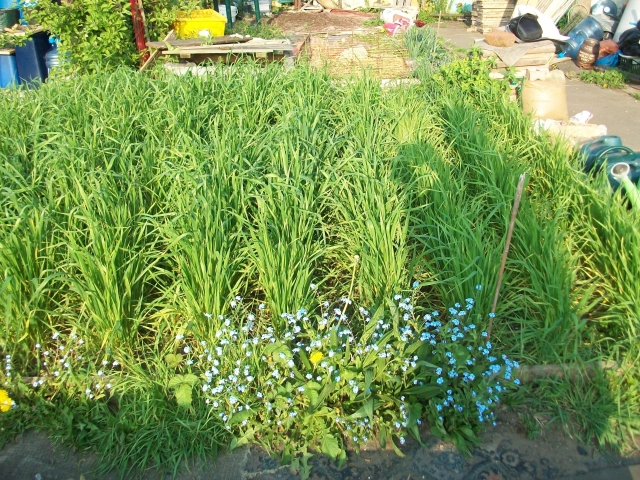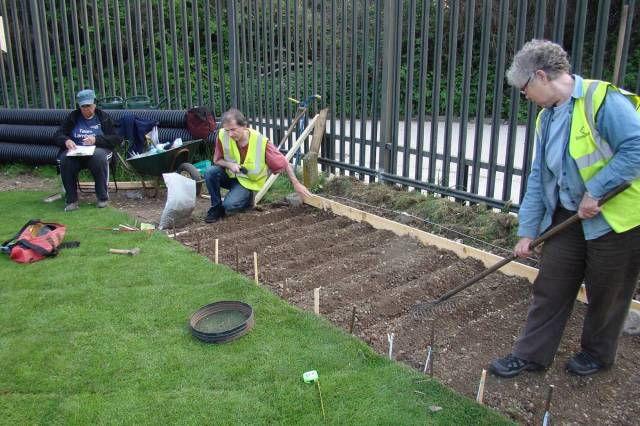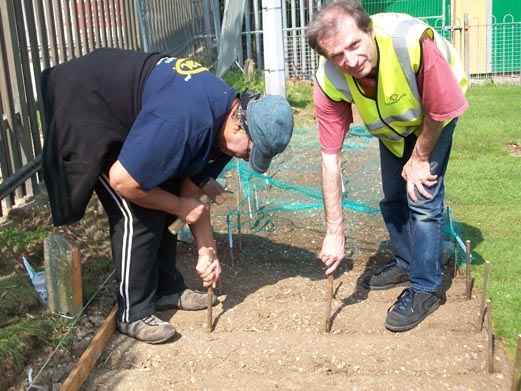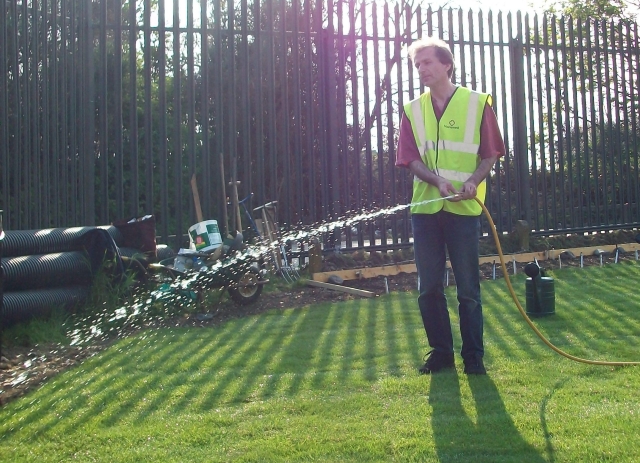Over the weekend, hard-working volunteers from the Friends of Windmill Gardens planted up a bed of heritage wheat and barley on the ridge behind Brixton Windmill.
Andy Forbes, secretary of the Brockwell Bake association, which provided the seeds from its stocks and from those of the national Small Cereals Collection at the UK’s John Innes Centre agricultural research centre, has answered some of our questions about heritage varieties of cereals.
What exactly is heritage wheat?
Heritage wheat refers to the varieties of wheat that were grown before the “Green Revolution” in the 1960s. All modern wheat varieties are derived from crosses with a dwarf wheat from Japan and therefore grow to only around two feet of height. This development, which was duplicated in other crops such as rice, tripled or even quadrupled yields – but at a cost. Because their stalks (straw) are shorter, more grain can be produced in the ears, so fertiliser can be applied without the risk of the crop falling over. Their root systems are also quite shallow, adapted for reliance on chemical fertilisers to grow. However, because of their short height, they don’t shade out weeds when they grow, so farmers also need to apply herbicides. The resulting genetically homogenous crop and field then become more vulnerable to pest and disease epidemics, so fungicides and pesticides are applied.
Heritage wheat, by contrast, is much taller, shading out weeds, and can tolerate much poorer soils because it has a bigger root system to seek out nutrients. But if you you apply fertiliser it grows too tall and flops over!
The soil behind Brixton Windmill is quite stony and of course we won’t be applying chemicals or fertiliser to any of the sowings. We have planted some rows of modern wheat alongside the heritage wheat there, so it will be very interesting to compare how they grow compared with the heritage lines.
What varieties of heritage wheat have we planted by Brixton Windmill?
We have planted 10 types of heritage spring wheat: Japhet, Old Welsh April bearded, English April Bearded, Swedish March Bearded, Atle, Red Fife, Hatif Inversable, White Fife and Red Marvel. You can see photos with further information on each wheat on the Brockwell Bake website.
We also planted 34 varieties of heritage barley. We’ve been trying to find varieties that were around before the variety Chevalier, which was introduced in the 1860s and was particularly good for brewing but maybe not so good for barley bread. In particular we have 17 with origins in Wales, where barley bread used to be the staple diet, and the results of our harvest (if successful) will be passed to Aberystwyth Botanical Gardens for growing on there next season.
Wheat and barley are both self fertilising. Each flower on the ear only opens for around 20 minutes, and is fertilised by its own pollen on all but the very rarest of occasions. So even though we have sown 13 wheat and 34 barley lines, we are very unlikely to see any new crosses occurring, and the heritage of genetic traits of each line will be preserved.

Hopefully, our crops will do as well as this heritage winter wheat grown on an allotment (photo by Jean Kerrigan)
What are the obstacles to growing more heritage varieties of cereal?
By law, any agricultural crop planted today has to pass two tests. The DUS test stands for distinctness, uniformity and stability, and the CUV test (“cultivation use value”) means the crop must prove itself as good as or better than those already listed when farmed “conventionally” (ie with high chemical inputs). These tests are supposed to ensure good-quality seed that meets certain standards.
However, the tests, which cost £2,000+ a year for each variety, mean that only varieties of cereals and other crops developed since the Green Revolution are available to farmers, even organic farmers, threatening the survival of heritage lines whose genetic diversity may be crucial to us in the future. If the variety has not passed these tests, you can only plant up to one hectare for education or research.
Since 2008 the UK as part of the EU has amended the seed control regulations to allow the listing of “agricultural conservation varieties and landraces” threatened by genetic erosion as permitted commercial crops in their historical region or country of origin without having to pass DUS and CUV tests. At the moment there are no such lines of cereals listed in the UK. Along with several wheats traditional to south east England being grown by Brockwell Bake, our Hen Gymro barley sowings may be one of the first examples of heritage cereals to gain this new category of permitted seed listing and therefore become available for farmers to legally sow again.
What are the advantages of heritage cereals over modern varieties?
In the UK, most surviving heritage wheats in our national collection are more or less pure “commercial cultivar” lines which started to be bred and sold in the late 18th century. But we also have a few examples of landraces, or mixed varieties created and selected by farmers to suit their local conditions. Landraces are more genetically diverse than the early commercial varieties, which lets them adapt to diverse growing conditions – the April Bearded varieties of spring wheat are most likely landraces. In those days we adapted the crop to suit the environment and different seasons. Nowadays it’s the other way round – we adapt the environment with heavy use of machinery, fertilisers, herbicides, pesticides, growth regulators and sometimes irrigation to suit the crop.
Because modern wheats share a limited number of ancestors, they are effectively inbred, and this, along with the mono-culture fashion in which they tend to be grown (genetically homogenous fields with all other plant life blasted away with chemicals), exposes the world wheat crop to the threat of epidemic failure. In fact, there is one disease that nearly all modern wheats are currently susceptible to: a rust (UG99) that originated in Uganda in 1999, which is spreading with even more virulent “daughter” strains from Africa into the Middle East and is now threatening Afghanistan, India and China. Agronomists are at the moment searching gene banks for heritage wheats that could be cross-bred with modern wheats and provide resistance to UG99.
Another reason to keep planting heritage cereals is that we face in the next few decades a “peak phosphorous” crisis similar to “peak oil”. In other words, the raw material of chemical fertiliser, phosphorous, is approaching peak production and could run out before the end of the century. If we need to farm without inorganic fertiliser, many experts believe heritage wheats outperform the modern varieties in stability and dependability of yield across seasons and locations.
It’s not impossible the specific seed we planted this last weekend could hold the key to meeting future world food crises!





You must be logged in to post a comment.